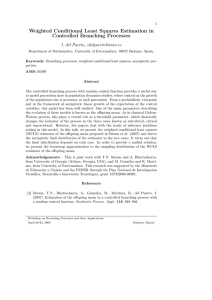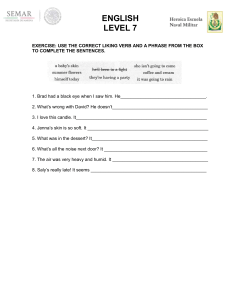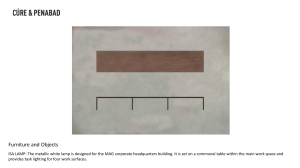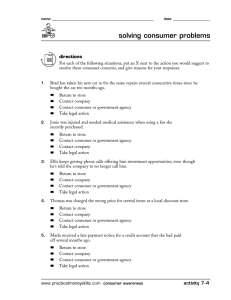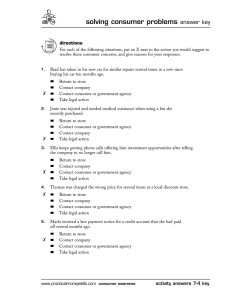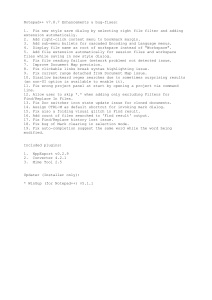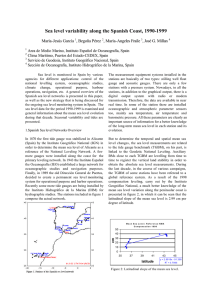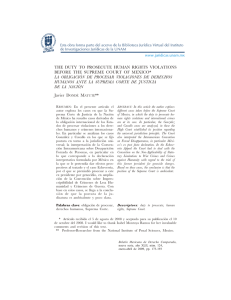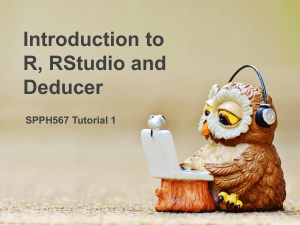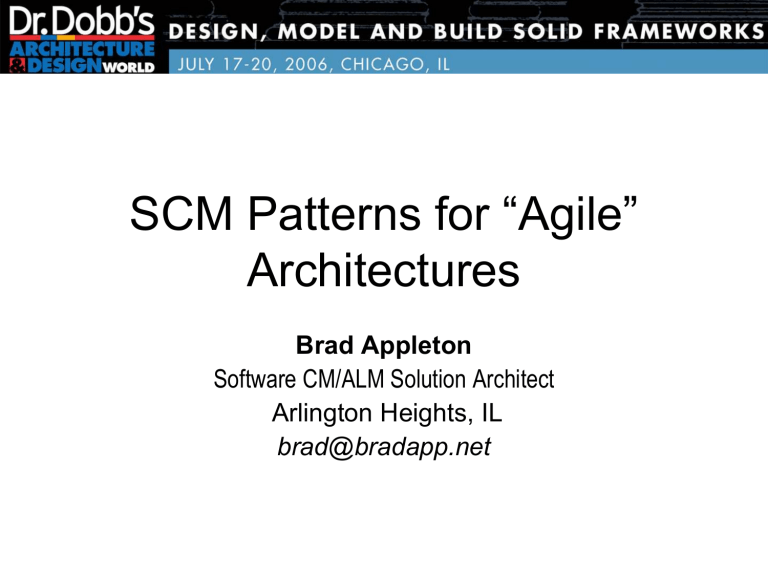
SCM Patterns for “Agile” Architectures Brad Appleton Software CM/ALM Solution Architect Arlington Heights, IL [email protected] Agenda • Part I: Background – – – – – What is Architecture? Architectural Views What is Agility? Lean & TOC What is Agile Architecture? What is SCM? SCM & Architecture Core SCM Pattern Concepts • Part II: The Patterns – – – – – Codeline Patterns Build/Integration Patterns Promotion “Leveling” Patterns Variability Management Wrap-Up 2 Part I: Background/Foundation 3 What is “Software Architecture”? The fundamental organization of a system: • embodied in its components, • their relationships to each other and the environment, • and the principles governing its design and evolution -- IEEE 1471-2000 4 4+1 Views model of Software Architecture (Kruchten & UML/RUP) Implementation View Logical View Analysts/Designers Structure Process View Programmers Configuration Mgmt End-user Functionality System Integrators Performance Scalability Throughput Conceptual Use-Case View Deployment View System Engineering System topology Delivery, installation Communication Physical 5 What is Agility? “The ability to both create and respond to change in order to profit in a turbulent business environment.” -- James Highsmith, Agile Software Development Ecosystems Rapid Response with Efficiency in Motion, Economy of Effort, Energy in Execution, and Efficacy of Impact! 6 Agile Development Characteristics Adaptive – responsive to change in needs & requirements via continuous feedback and reflective retrospection Goal-driven – focus on producing executable-results (working functionality) in order of highest business value. Iterative – short development cycles, frequent releases, regular feedback Lean – simple design, streamlined processes, elimination of redundant information, minimal intermediate artifacts Emergent behavior – highly collaborative self-organizing teams in close interaction with stakeholders 7 Principles of Lean Development • Eliminate Waste (Minimize Artifacts & Add Nothing but Value) • Build Quality In (Satisfy All Stakeholders & Deploy • • • • • Comprehensive Testing) Amplify Learning (Learn by Experimentation) Defer Commitment (Decide as Late as Possible) Deliver Fast (Deliver as Fast as Possible) Respect People (Decide as Low as Possible) Optimize the “Whole” (Measure Business Impact & Optimize Across Organizations) Source: Mary & Tom Poppendieck, http://www.poppendieck.com/ 8 Theory of Constraints – 5 Focusing Steps 1. 2. 3. 4. 5. IDENTIFY the Constraint EXPLOIT the Constraint SUBORDINATE to the Constraint ELEVATE the Constraint Repeat – PREVENT INERTIA from becoming the Constraint 9 What is an “Agile Architecture”? • Gracefully evolves & adapts to meet changing needs & constraints • Resilient & responsive to change 10 What is SCM? (Traditional view) • Configuration Identification • Configuration Control • Status Accounting • Audit & Review • Build & Release Management • Process Management, etc 11 What is SCM? (Agile view) SCM is a set of structures & practices that: • Facilitate frequent feedback on build quality & product suitability • Enable changing & building systems in repeatable, agile fashion with: – Increased productivity – Enhanced responsiveness to customers – Increased quality • Help your customers feel more confident Customer Requests Changes R1 R1 Business Value R2 R2 V1 V2 V3 Copyright © 2003-2006 by Brad Appleton & Steve Berczuk Results 12 What is SCM? (Architectural view) Software Configuration Management is the architecture of the evolution of architecture! 4+2 views of SCM “Architecture” 1) The Project structures 2) The flow of Evolution 3) Product Objects/Artifacts 4) Your Environment +1) Your Processes +2) Your Organization 13 4+2 Views of SCM Architecture Enterprise (Who) CR CR Product (What) CR Project/Program Managers, QA/V&V Architects/Engineers/Builders Status Accounting Product/Artifact Structure Request/Defect Management Build/Release Engineering Change Planning/Tracking (How) decision binding-time & change/creation-time Process-users/engineers change/creation time & decision binding-time Process Workflow Procedures/Training Practices/Patterns Content Project (Why) diversity & scale Management Teaming & Collaboration Producers & Consumers Metrics/Reports/Audits Process Environment Integrators/Release Mgrs Versioning/Baselining Branching & Merging Parallel Development IT Engineering/Support Workspaces/Repositories Application Integration Computing Infrastructure (When) Conceptual (Where) scale & diversity Physical Copyright © 1997-2006 by Brad Appleton Context Evolution 14 Core SCM Patterns Concepts • What are Patterns? • Codeline/Branch • Configuration – Version – Revision – Label • Workspace 15 What are Patterns and Pattern Languages? • A pattern is a solution to a problem in a context. • Patterns capture common knowledge. • Pattern languages guide you in the process of building something using patterns. Each pattern is applied in the correct way at the correct time. 16 Codeline • A codeline contains every version of every artifact over one evolutionary path. R1 R2 R1 R2 V1 V2 V3 Copyright © 2003-2006 by Steve Berczuk & Brad Appleton 17 Branching • Branch: A codeline that contains work that derives (and diverges) from another codeline. • Branch of a file: A revision of a file that uses the trunk revision as a starting point. /branch /main 18 Versions, Revisions and Labels • Revision: An element at a point in time. • Configuration: A snapshot of the codeline at a point in time. • Version: A labeled configuration. R1 R2 R1 R2 V1 V2 Copyright © 2003-2006 by Steve Berczuk & Brad Appleton V3 19 Workspace • Everything you need to build the Product – Code, Scripts, Database resources, etc. 20 Part II: The Patterns • Codeline Patterns • Build/Integration Patterns • Promotion “Leveling” Patterns • Variability Management • Wrap-Up 21 SCM Patterns across the 4 Views Project Product • Task-Based Development • Promotion Leveling CR CR Evolution • Mainline • Release Line • Active Development Line • Release-Prep Codeline • Task Branch • Private Branch CR • Private Build • Integration Build • Private Checkpoint • Workspace Update • Smoke/Regression Test • Variability Mgmt Environment • Private Workspace • Integration Workspace • Staging Area Copyright © 2004-2006 by Brad Appleton 22 Codeline Patterns • Mainline • Active Development Line • Codeline Policy • Release Line • Release-Prep Codeline • Task Branch • Private Branch 23 Codeline Structures for Agility • How many codelines should you be working from? • What should the rules be for check-ins? • Codelines are the integration point for everyone’s work. • Codeline structure determines the pulse of the project. 24 Mainline • You want to simplify your codeline structure. • How do you keep the number of codelines manageable (and minimize merging)? 25 Mainline (Forces & Tradeoffs) • A Branch is a useful tool for isolating yourself from change. • Branching can require merging, which can be difficult. • Separate codelines seem like a logical way to organize work. • You will need to integrate all of the work together. • You want to maximize concurrency while minimizing problems cause by deferred integration. 26 Mainline (Solution) • Keep Latest release/project efforts on Mainline • Branch Late/Lazy to support & maintain previous releases [use nested synchronization] DON’T cascade new branches for follow-on projects/releases [avoid staircase branching] DO sync-merge to Mainline (“mainlining”) to reduce breadth of branch tree 27 Mainline /main 1.0 /rel1.1 2.0 1.1 /rel2.1 3.0 2.1 vs. Cascading Staircase /rel3.0 /rel1.0 /rel2.0 2.0 1.0 /rel2.1 /rel1.1 3.0 2.1 1.1 28 Active Development Line • You are developing on a Mainline. • How do you keep a rapidly evolving codeline stable enough to be useful (but not impede progress)? 29 Active Line (Forces & Tradeoffs) • • • • A Mainline is a synchronization point. More frequent check-ins are good. A bad check-in affects everyone. If testing takes too long: Fewer check-ins: – Human Nature – Time • Fewer check-ins slow project’s pulse. 30 Active Development Line (Solution) • Use an Active Development Line. • Have check-in policies suitable for a “good enough” codeline. • Unresolved: – – – – – Doing development: Private Workspace Keeping the codeline stable: Smoke Test Managing maintenance versions: Release Line Dealing with potentially tricky changes: Task Branch Avoiding code freeze: Release Prep Codeline 32 Codeline Policy • Active Development Line and Release Line (etc.) need to have different rules. • How do developers know how and when to use each codeline? 33 Codeline Policy (Forces & Tradeoffs) • Different codelines have different needs, and different rules. • You need documentation. (But how much?) • How do you explain a policy? 34 Codeline Policy (Solution) • Define the rules for each codeline as a Codeline Policy. The policy should be concise and auditable. • Consider tools to enforce the policy. Active Development Line Private Versions Release Line Release Prep Codeline Codeline Policy Copyright © 2003-2006 by Steve Berczuk & Brad Appleton 35 Release Line • You want to maintain an Active Development Line. • How do you do maintenance on a released version without interfering with current work? 36 Release Line (Forces & Tradeoffs) • A codeline for a released version needs a Codeline Policy that enforces stability. • Day-to-day development will move too slowly if you are trying to always be ready to ship. 37 Release Line (Solution) • Split maintenance/release activity from the Active Development Line and into a Release Line. • Allow the line to progress on its own for fixes. /Release-1 /main Active Development Line Release Line fixes Release 1 work Copyright © 2003-2006 by Steve Berczuk & Brad Appleton 38 Release Prep Codeline • You want to maintain an Active Development Line. • How do you stabilize a codeline for an imminent release while allowing new work to continue on an active codeline? 39 Release-Prep Codeline (Forces & Tradeoffs) • You want to stabilize a codeline so you can ship it. • A code freeze slows things down too much. • Branches have overhead. 40 Release Prep Codeline (Solution) • Branch instead of freeze. Create a Release Prep Codeline (a branch) when code is approaching release quality. • Leave the Mainline for active development. • The Release Prep Codeline becomes the Release Line (with a stricter policy) • Note: If only a few people are doing work on the next release, consider a Task Branch instead. Active Development Line Release Prep Codeline 41 Task Branch Created exclusively for the duration of a single development task – Good for risky or experimental efforts 42 Private Branch Created exclusively for a single developer (or two) for the duration of a project – Encompasses multiple (sequential) changetasks – Good for implementing Private Checkpoints 43 Build/Integration Patterns • • • • • • • • Private Checkpoint Workspace Update Task-Level Commit Private Build Integration Build The Three Builds Smoke Test Regression Test 44 Private Checkpoint • An Active Development Line will break if people check in half-finished tasks. • How can you experiment with complex changes and still get the benefits of version management? 45 Private Checkpoint (Forces & Tradeoffs) • Sometimes you may want to checkpoint an intermediate step of a long, complex change. • Your version management system provides the facilities for checkpointing. • You don’t want to publish intermediate steps. 46 Private Checkpoint (Solution) • Provide developers with a mechanism for checkpointing changes using a simple interface. • Can Implement as any of the following: – Private Archive/Repository – Private Branch – Task Branch – Private Label/Tag 47 Workspace Update • Synchronize your workspace with the codeline, without breaking the codeline • Reconcile recent changes together sooner & keep developers aware of others activities 48 Workspace Update codeline private workspace Developer 49 Task Level Commit • You need to associate changes with an Integration Build. • How much work should you do before checking in files? 50 Task Level Commit (Forces & Tradeoffs) • The smaller the task, the easier it is to roll back. • A check-in requires some work. • It is tempting to make many small changes per check-in. • You may have an issue system that identifies units of work. 51 Task Level Commit (Solution) Do one commit per small-grained task. • [Compare with Task Branch for long lived efforts] codeline commit private workspace Developer 52 Private Development Build • You need to build to test what is in your Private Workspace. • How do you verify that your changes do not break the system before you commit them to the Repository? 53 Private Development Build (Forces & Tradeoffs) • Developer Workspaces have different needs than the system build. • The system build can be complicated. • Checking-in changes that break the Integration Build is bad. 54 Private Build (Solution) • Build the system using the same mechanisms as the central integration build, a Private Development Build. • This mechanism should match the integration build. • Do this before checking in changes! • Update to the codeline head before a build. 55 Integration Build • What is done in a Private Workspace must be shared with the world. • How do you make sure that the code base always builds reliably? 56 Integration Build (Forces & Tradeoffs) • People do work independently. • Private Development Builds are a way to check the build. • Building everything may take a long time. • You want to ensure that what is checkedin works. 57 Integration Build (Solution) • Do a centralized build for the entire code base. Copyright © 2003-2006 by Steve Berczuk & Brad Appleton 58 The Three Builds • Private Development Build – Provides a consistent way for the developer to build the software in the confines of their private workspace • Team Integration Build – Synchronize team, feedback on code quality/integrity • Formal Release Build – Creates the deployable package • Why?: – Productivity, predictability, documented, ability to delegate build activity without compromising CM or quality. 59 The Three Builds Task Multi-Task Coordination Product / System Integration Build Private Build Component / Product Unit / Comp. Iteration / Release Release Build Developer Development Team Customer / Test (V&V) Copyright © 2003-2006 by Brad Appleton & Steve Berczuk 60 Smoke Test • You need to verify an Integration Build or a Private Build so that you can maintain an Active Development Line? • How do you verify that the system still works after a change? 61 Smoke Test (Forces & Tradeoffs) • Exhaustive testing is best for ensuring quality. • The longer the test, the longer the checkin, encouraging less frequent check-ins. 62 Smoke Test (Solution) • Subject each build to a Smoke Test that verifies that the application has not broken in an obvious way. • Unresolved: A Smoke Test is not comprehensive. You will need to find: – Problems you think are fixed: Regression Test – Low level accuracy of interfaces: Unit Test 63 Regression Test • A Smoke Test is good but not comprehensive. • How do you ensure that existing code does not get worse after you make changes? 64 Regression Test (Forces & Tradeoffs) • Comprehensive testing takes time. • It is good practice to add a test whenever you find a problem. • When an old problem recurs, you want to be able to identify when this happened. 65 Regression Test (Solution) • Develop Regression Tests based on test cases that the system has failed in the past. • Run Regression Tests whenever you want to validate the system. Smoke Test Regression Test 66 Promotion “Leveling” Patterns • • • • • • What is “Promotion”? Version Promotion Promotion Workspaces Branch Promotion Promotion Branches Label Promotion 67 What is a Promotion Lifecycle? • A series of stages/levels that our end-result must pass through before we are willing to “release” it to others • A sequence of significant milestone events, each of which represents either: – an increase in confidence, or … – a transfer of responsibility in assuring the release-quality of a deliverable Example Promotion Lifecycles: • {Developed, Reviewed, Tested, Audited, Released} • {Development, Staged, Tested, Validated, Production} • {Private, Team, QA, Customer, Failed} 68 Common Promotion Mechanisms • • • • • • Version Promotion (Promoted Versions) Promotion Workspaces Branch Promotion (Promoted Branch) Promotion Branches (Promotion Branching) Label Promotion (Promoted Label) Promotion Labels (Promotion Labeling) – Equivalent to Version Promotion using Labels as the “attribute values” for the promotion-level 69 Version Promotion • The most recent version of each file on the codeline is associated with a promotion level • File versions are “promoted” to the next level by “advancing” their promotion-level attribute • Whenever a file is “updated”, it starts over again at the initial promotion level. PRO: Can easily discern if all files on the tip of the codeline are at the correct promotion level, and which files aren’t CON: Can be very cumbersome to implement if you have to do it yourself 70 Version Promotion F1=DEV F2=DEV File F1 F1=INT F2=INT F1=INT F2=DEV R1 File F2 R2 R1 R2 V1 V2 Copyright © 2003-2006 by Brad Appleton & Steve Berczuk V3 71 Promotion Workspaces • Uses a separate workspace or “staging area” for housing built deliverables deliverables • When a build progresses from one level to the next, the built results are “pushed” to the next-level workspace • Common example uses three “vaults” (staging areas): 1. Development Integration “Vault” 2. Formal Integration+Test “Vault” 3. Production Distribution “Vault” (Release-Area) PRO: No confusion over which versions in the workspace are at which “level” CON: Can be time-consuming to copy/link file versions across workspaces or staging areas 72 Promotion Workspaces Formal Integration+Test Production Distribution Development Integration 73 Branch Promotion • Associate promotion-level attribute with an entire codeline • When tip of the codeline progresses from one level to the next, advance the branch’s promotion-level PRO: Very quick & easy to “promote” – no files need to be copied/linked CON: Okay for handing off an entire branch but not as useful when using the same codeline for frequent handoffs (can’t tell status of previous handoff anymore) 74 Branch Promotion 75 Promotion Branches • Uses separate branch/codeline for each promotion level • When a build progresses from one level to the next, the versions are “pushed” (copymerged) • Very similar to promotion workspaces, but with codelines instead (or in addition) PRO: Codelines make for nice “integration territories” when transferring responsibility – avoids “turf wars” and “policy disputes” from competing groups by giving each their own codeline and codeline policy CON: Creates a new version when promoting to the next level (even if no changes were needed) 76 Promotion Branching 77 Label Promotion • Associate promotion-level attribute with each label/build • When build progresses from one level to the next, advance the label’s promotion-level PRO: Very quick & easy to “promote” – no files need to be copied/linked and no versions to merge; allows for multiple builds on the same codeline to each go thru their own promotion levels independently CON: Can be somewhat unwieldy to implement if your tool doesn’t readily support “attributes” on a label/tag 78 Label Promotion 79 Variability Management • What is Product Variability? • Why Product Variability? • Branching-time or Binding-time? • Binding Times • Build/Package Options • Feature Configuration • Business Rules • Composition, Inheritance & Aspects 80 What is Product Variability? Product-Lines & Product-Families: • Variability of a single codebase across multiple products: Multi-Variant Product: • Variability of a single codebase across the same product: 81 Multiple Products & Multiple Variants Product-Lines & Product-Families: • An entire line/family of different products with some “core” (shared) components & functionality • Each product has some unique combination of additional functionality and/or functional “variation” Multi-Variant Product: • Many (functional) variations of the same (product) theme • Variations are often customer/market-specific • Different from supporting legacy releases (multi-project): – because the functional differences aren’t separated by time, but by market/customer and/or technology/platform. 82 Why Product Variability? A Company may offer product variability because they may believe … • • • • “One size does not fit all!” It will improve competitive advantage It will increase their market size/share It will uniquely differentiation them in the market (branding) • Etc., 83 Branching-time or Binding-time? • Many attempt product-variability with Branching by using a codeline per variant; Don’t do this! – Branching is for isolation/synchronization of code across people & places during the same time-period: • Concurrent/parallel & remote/distributed development • Maintaining legacy/historical versions of an installbase 84 Branching-time or Binding-time? Address Variability using late-binding (instead of branching) whenever possible! – Branching for Variability is like Cut-n-Paste Reuse! • Creates multiple instances of the same code that all need to be repaired for the same “bugfix” or enhancement • Creates more merging & integration for something that is fundamentally not an issue of isolation+synchronization 85 Binding-Times Example decision binding times for a point of functional variation (variation point): Source reuse time - when reusing a configurable source artifact Development time Static code instantiation time - during generation/assembly of code for build Build time - during compilation or related processing Source: www.softwareproductlines.com 86 More Binding-Times Package time - when assembling binary & executable collections Customer customizations. Decisions bound during custom coding at customer site Install/Upgrade time. Decisions bound during the installation of the software product Startup time. Decisions bound during system startup Runtime. Decisions bound when the system is executing Source: www.softwareproductlines.com 87 Build/Package Options Manage platform differences with well known design & architecture patterns that “bind” at build-time or package-time: • Wrapper-Façade [POSA2] • Numerous patterns from the Gang-of-Four design patterns book (Factory, Factory Method, Bridge, etc.) • Combine with Make/ANT options & variables and judicious use of conditional compilation 88 Post-Release Feature Configuration Manage variation in features/feature-sets with selection & deselection patterns: • Enables/disable features and services at postrelease binding-times (install/upgrade-time & run-time) • Component Configurator, Interceptor, Extension Interface [POSA2] • Variations of Register/Unregister and PublishSubscribe in a feature/service “registry” 89 Business Rules Differences in policy/mechanism may be handled using a business-rules approach • Maintains a single codebase + codeline to deliver a single product with multiple possible configurations of rules and rule-settings • Strategy, Template Method, Adapter, Decorator [“Gang of Four”] • Adaptive Object-Model [Yoder & Johnson] • Application “resource settings” 90 Composition, Inheritance & Aspects • Composition & Delegation are usually best • Inheritance may be useful in some cases – if the type of configuration needed really does fit a single hierarchical model of increasing specialization • In other cases, an aspect-oriented approach might be better – if the “seams” of configurability cut-across multiple components/services 91 Wrap Up • • • • Lean Branching CM Constraints Promotion Notions SCM Patterns Book • Managing Multiple Variants/Products • Other “Agile SCM” Resources 92 Principles of “Lean” Branching • Deliver as fast as possible – Integrate fine-grained change-tasks as early as possible • Decide as late as possible – Branch as late as possible • Decide as low as possible – Developers reconcile merges and commit their own changes • Optimize across the “Whole” – Use a Mainline to maintain a manageable branching structure 93 Eliminate CM Constraints Remove Integration/Build/Test “Bottlenecks” • One of the single biggest “drags” on development feedback cycle-time is the “friction” that comes from prohibitive build-times, or long testing-cycles • These force development to either freeze or branch the code-base for significant periods of time while waiting for integration/build/test activities to complete • Integration+Build tools/scripts, code structure, and network resources must be leveraged appropriately to minimize build times 94 Applicability of Promotion Mechanisms • Can mix & match mechanisms as appropriate – Branch Promotion: useful when the branch is the unit of handoff or when handoffs are infrequent on that branch – Promotion Branching: useful for separate levels of integration (so merging would be performed anyway) or separate owners/policies – Label Promotion: well suited for a promotion levels at the same level (scope) of integration. • Be wary of Branching/Labeling for promotion purposes if wouldn’t otherwise make sense to branch/label or merge • Don’t “force-fit”! Some of these things emerge “naturally” – Private/Task Branch ⇒ Active Line ⇒ Release Line – Private Build ⇒ Integration Build ⇒ QA/Release Build 95 Managing Product Variability • Use Late-Binding instead of Branching: – Build/Package Options – Feature Configuration/Selection – Business Rules • Think about which of the following needs to "vary" and what needs to stay the same: – Interface vs. Implementation vs. Integration – Container vs. Content vs. Context • Commonality & variability analysis helps identify the core dimensions of variation for your project • Use a combination of strategies based on the different types of needed variation and the "dimension" in which each one operates 96 Our Book • Pub Nov 2002 By Addison-Wesley Professional www.scmpatterns.com 97 Other Agile SCM Resources • http://www.scmpatterns.com/ – SCM Patterns book has most of the codeline, workspace & build patterns presented here; and this site has a reference card and synopses for the patterns • http://www.cmwiki.com/AgileSCMArticles – Numerous links to specific “Agile SCM” papers on the subject of patterns for continuous integration, promotion, staging, branching & merging, and more • http://blog.bradapp.net/ and http://acme.bradapp.net/ • http://www.berczuk.com/ • http://www.cmcrossroads.com/ 98 Thank You! Salamat Yum botic Mahalo Xie xie Arigato 99
